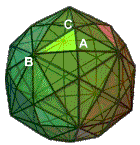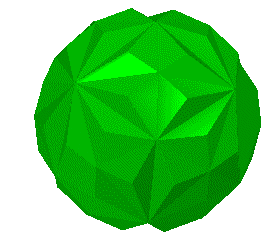|
|
 |
 |
|
Disdyakis triacontahedron |
144 Polyhedron |
| << Previous 1... 11 12 13 [14] 15 Next >> |
How YAHWEH and the Decad determine the geometrical composition of the Polyhedral Tree of Life
Imagine the 144 Polyhedron and the disdyakis triacontahedron constructed from triangles. When their vertices are joined to their centres, each of their edges is the side of an internal triangle one of whose corners is located at the centre of each polyhedron. Using their data shown below:
144 Polyhedron: Number of vertices = 74
(72 surrounding an axis that comprises three corners & two sides); number of edges
= 216; number of
triangular faces = 144;
Disdyakis triacontahedron: Number of vertices =
62 (60 surrounding
an axis that comprises three corner points & two sides); number of edges = 180; number of trIangular
faces = 120,
the following table lists the corners, sides & triangles making up the two polyhedra:
| Corners | Sides | Triangles | Total | |
| 144 Polyhedron | 72 + 3 = 75 | 216 + 72 + 2 = 288 + 2 = 290 | 144 + 216 = 360 | 720 + 5 = 725 |
| Disdyakis triacontahedron | 60 + 3 = 63 | 180 + 60 + 2 = 240 + 2 = 242 | 120 + 180 = 300 | 600 + 5 = 605 |
| Total | 132 + 6 = 138 | 528 + 4 = 532 | 264 + 396 = 660 | 1320 + 10 = 1330 |
We see that:
|
|
 |
 |
|
Disdyakis triacontahedron |
144 Polyhedron |
pillars that coincide with corners of polygons, namely, the pair of triangles and the pair of hexagons. This leaves 74 blue yods that are intrinsic to the 1-tree. Of the 70 corners of the (7+7) enfolded polygons, (70−6=64) corners are, likewise, intrinsic to them, where 64 is the number value of Nogah, the Mundane Chakra of Netzach. Hence, there are (74+64=138) yods or corners that are unshared between the outer and inner Trees of Life. They symbolize the 138 corners of the 660 triangles needed to construct the 144 Polyhedron and the disdyakis triacontahedron. The 20 red corners of the pair of dodecagons outside the root edge denote the 20 C vertices of the disdyakis triacontahedron, the 30 purple corners of the two squares, pentagons, hexagons & decagons outside the root edge denote its 30 A vertices and the 12 green corners of the two octagons outside the root edge denote its 12 B vertices. Kether, Tiphareth, Yesod & Malkuth denote the four vertices of both polyhedra at the ends of their axes, the centres of which are appropriately denoted by the two endpoints of the root edge (the upper endpoint corresponds to the centre of the 144 Polyhedron and the lower one corresponds to the centre of the disdyakis triacontahedron);
12
32
52 = 72
92
112
132 152 172 192 . This beautiful property shows how the Decad symbolized by the tetractys determines the geometrical composition of the Polyhedral Tree of Life, for the largest odd integer in the array is 19, which is the tenth odd integer. Moreover, as pointed out in the previous comment, the two separate polyhedra have 67×10 corners & sides, where 67 is the 19th prime number!;
|
132 |
||||
| 132 | 132 | |||
| 1320 = |
132 |
132 |
132 |
|
| 132 | 132 | 132 | 132 |
The apex denotes the number of corners, the second row denotes the number of faces, the third row denotes the number of internal triangles and the fourth row denotes the number of sides! The crucial property that makes this possible is that the number of vertices of the two polyhedra that surround their axes is 132, which happens to be exactly half the total number (264) of their faces. This can be seen by writing Euler's formula for two polyhedra P1 & P2 with, respectively, C1 & C2 vertices, E1 & E2 edges and F1 & F2 faces:
C1 − E1 + F1 = 2
and
C2 − E2 + F2 = 2.
Adding,
C1 + C2 − (E1 + E2) + F1 + F2 = 4.
Then, as F1 + F2 = 264, C1 = c1 + 2 and C2 = c2 + 2, where c1 & c2 are the numbers of vertices surrounding the axes of P1 & P2,
E1 + E2 = c1 + c2 + 264.
If c1 + c2 = 132, i.e., half the number of faces of P1 & P2, then E1 + E2 = 396 = 3×132, so that the number of sides of the triangles surrounding their axes = E1 + c1 + E2 + c2 = (E1 + E2) + c1 + c2 = 3×132 + 132 = 4×132. ADONAI prescribes this common factor of the various numbers determining the geometrical composition of the Polyhedral Tree of Life because 132 is the 65th even integer after 2.
In one of his books, the great physicist Richard Feynman said:
"There is a most profound and beautiful question associated with the observed coupling constant, e — the amplitude for a real electron to emit or absorb a real photon. It is a simple number that has been experimentally determined to be close to -0.08542455. (My physicist friends won't recognize this number, because they like to remember it as the inverse of its square: about 137.03597 with about an uncertainty of about 2 in the last decimal place. It has been a mystery ever since it was discovered more than fifty years ago, and all good theoretical physicists put this number up on their wall and worry about it.) Immediately you would like to know where this number for a coupling comes from: is it related to pi or perhaps to the base of natural logarithms? Nobody knows. It's one of the greatest damn mysteries of physics: a magic number that comes to us with no understanding by man. You might say the "hand of God" wrote that number, and "we don't know how He pushed his pencil." We know what kind of a dance to do experimentally to measure this number very accurately, but we don't know what kind of dance to do on the computer to make this number come out, without putting it in secretly! ........Richard P. Feynman (1985). QED: "The Strange Theory of Light and Matter". Princeton University Press. p. 129.
The magnitude of the coupling constant α = e2/ħc for the electromagnetic field has yet to be calculated from first principles. The closeness of its reciprocal to the number 137 has led physicists to speculate that this number has a place in a "grand, unified theory" that truly unifies the forces of nature. We can now explain why it should do so. Like numbers such as 248 and 496, which are encountered in superstring theory, the number 137 is a primary parameter of holistic systems. For example, it is:
There is, therefore, no more mystery about why the "magic number" 137 is present in quantum electrodynamics, for it is a characteristic parameter of all sacred geometries (see here under the heading "137") embodying the divine blueprint, as manifested in the physical universe of matter and its forces — in particular, the electromagnetic field described by QED. This statement is not a speculation about the metaphysical status of the number 137 based upon religious dogma or New Age philosophy. Instead, it is a hard, mathematical fact, as provable as any theorem of Euclid's geometry. Contemplate this, marvel at it and reflect on its profound implications. Only if your humanistic or materialistic philosophy has no room for the notion of the 'sacred,' as manifested in sacred geometries, will you continue — like Prof. Feynman and "all good theoretical physicists" — to worry about the number 137.
* Proof: the number of yods in n overlapping Trees of Life whose (12n+4) triangles with (6n+4) corners and (16n+6) sides are tetractyses = 6n + 4 + 2×(16n+6) + 12n + 4 = 50n + 20. Therefore, 26 overlapping Trees have 1320 yods.
** Proof: the number of yods in the n-tree whose (12n+7) triangles are tetractyses with (6n+5) corners and (16n+9) sides = 6n + 5 + 2×(16n+9) + 12n + 7 = 50n + 30. Therefore, the 26-tree has (50×26 + 30 = 1330) yods.
| << Previous 1... 11 12 13 [14] 15 Next >> |